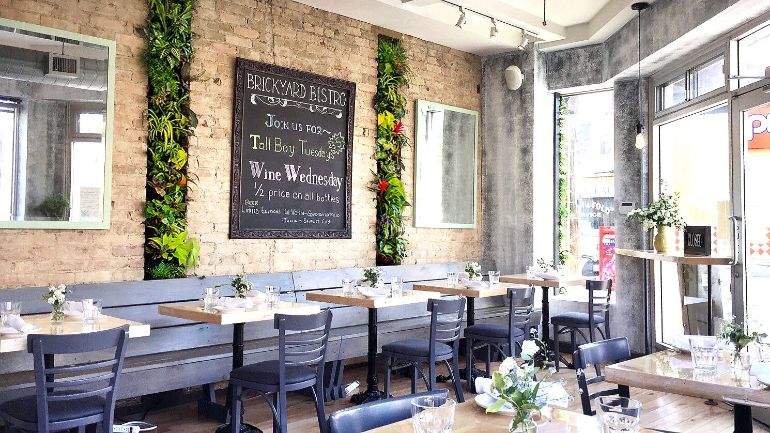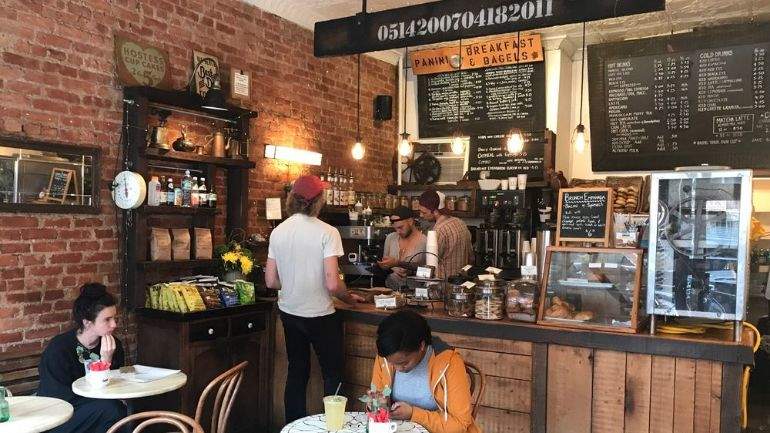When you think about the old neighborhood restaurant and cafe, you might picture a dank, dirty spot that serves cheap food and drink – not exactly the image that attracts customers.
But things are changing.
As urban sprawl continues extending out from city centers and the next generation starts buying homes in outlying areas, the neighborhood cafe has to deliver both quality food and attractive prices to survive – and thrive – through these changes.
What Is a Neighborhood Cafe?
A neighborhood cafe is a restaurant that straddles the lines between convenience, quality, and price – the three pillars of these venues. Neighborhood cafes are anchors within their community – a place to grab a coffee on the way to work, a place to grab a drink and unwind at the end of the day, or a place to grab brunch with the family on weekends before heading to a nearby park.
So what is the key to longevity as a neighborhood hangout? Here are our top five tips from three TouchBistro neighborhood restaurateurs.
1. Stay Ahead of Neighborhood Population Trends
Many restaurateurs are now flocking to neighborhoods ahead of that dirty G word: gentrification.
As urban sprawl becomes the norm, more and more young professionals are moving outside the downtown core of large cities to start families. But these ex-city dwellers are still used to concentrated, urban areas where it’s easy to find trendy restaurants that serve good quality food – without having to hop in a car.
As a result, this migration creates the perfect opportunity for restaurants to appeal to a neighborhood’s’ changing demographics.
Brickyard Bistro, a neighborhood bistro located in Greenwood-Coxwell of Toronto, jumped on this kind of opportunity at the right time. Historically home to brickyards (hence the restaurant’s name), Greenwood-Coxwell is a neighborhood that borders East Chinatown and Little India and has recently seen a demographic shift.

As aging immigrant families moved out of the neighborhood to capitalize on the rising incomes of their homes, the neighborhood has seen an influx of 30-something newlyweds – dual income dog owners with dreams of families on the way. According to a 2016 Statistics Canada Census, 79% of the neighborhood is comprised of married couples, 35% of which have no children – hello, disposable income.
“We took the space earlier because we knew it was going to blossom,” says Corey Durand, co-owner of Brickyard Bistro. “It marked the beginning of becoming a destination neighborhood that people will travel to because there’s more than just one choice. If there’s no room for them in one restaurant, they can go to another.”
But how do you find these up-and-coming neighborhoods?
Read the signs – and we don’t mean the stars.
Up-and-coming neighborhoods, those gems that are perfect for neighborhood bistros and cafes, have certain “tells,” such as:
- The presence of artists, who typically move to neighborhoods where they can afford to both live and work
- Major renovations in the works, either by the city or the residents
- Being on the outskirts of an already-trendy area
- Increase of young people, as mentioned above
- Improving neighborhood stats like crime, poverty, income, etc. (check a website like city-data.com)
If you’re looking for a new location, scope out the competition in the neighborhood as part of the research process. Is there any direct competition within a two-block radius? If so, are you differentiated enough for your business to thrive?
For example, there are two neighborhood cafes in the vicinity of Brickyard Bistro – one serving up Egyptian fare and the other dishing up French classics. But Brickyard Bistro still stands out because they serve comfort food with local and seasonal ingredients.
While convenience is definitely an important part of being a neighborhood restaurant, so is standing out from the competition. So before you set up shop, ensure that you are offering something unique that doesn’t already exist in the neighborhood (within a two-block radius).
So what are the benefits of getting into a neighborhood in its early stages of gentrification?
Get in early, take advantage of lower rents.
“It’s been a little bit of a slow build because we’re a neighborhood of homes,” says Corey, comparing his business to those located in the higher density, downtown core full of high rises – and high rents.
Traffic may be more sparse in the early days, but committing to a longer lease term (5–10 years) will help keep your fixed costs down – at least in the short-term. You should also plan for rent increases once that term is up – especially if the neighborhood is attracting more new businesses.
But if you’ve truly done your research on the neighborhood, then you should be confident about investing in the neighborhood. Corey says that patience is key.
2. Find the Right Balance: Consistency, Convenience, and Cost
Being a neighborhood cafe is a constant balancing act between consistency, convenience, and cost. If any one of these things drops behind the others, then you throw off the perceived value for your customers.
Be Consistent
While consistency is something that any good restaurant should be mindful of, it’s especially important for neighborhood restaurants because your customer base is within a concentrated area – one bad experience gets around quickly.
According to Dale Strickland, co-owner of East One Coffee Roasters (a micro roaster/coffee shop and restaurant located in Carroll Gardens, Brooklyn), they have an “extremely stringent coffee program and work all the time to make sure every single cup is served to a standard consistency.”

Consistency in a coffee shop setting is just a synonym for quality. You wouldn’t want to have watered down coffee or a cup that isn’t hot enough would you? As Goldilocks would say, it has to be “just right.”
Customers have a certain expectation for the restaurant food and drink they consumer regularly, as a part of their routine. When those expectations are met with varying degrees of delight and/or disappointment, it doesn’t make for a great customer experience.
What can you do to maintain consistency?
Invest the time to create standard operating procedures so that all your staff go through the same training process. This can include things from brand messaging, to step-by-step procedures on how to prepare menu items, to opening and closing procedures.
Another way is to have routine quality control checks or even employ friends and family to become secret shoppers to audit the guest experience. As staff turnover in the restaurant industry is higher than in other industries, quality control checks on everything from food quality to customer service is of utmost importance.
Prioritize Convenience
Convenience without jeopardizing quality is also extremely important.
“We feel that coffee is often a convenience in terms of proximity to people’s commute, how close you are to a subway stop or public transit,” says Dale.
East One also boosts their convenience factor by offering a range of items that make it a one-stop shop – not to mention giving themselves more opportunities to upsell and increase revenue. The neighborhood cafe has an in-house baking program to differentiate their offerings beyond the same, tired looking pastries that most of the city’s coffee shops buy from the same supplier.
Also offering quality breakfast goodies turns East One Coffee Roasters from a one-trick pony coffee shop to a convenient breakfast stop.
Make sure your own location is near main traffic routes and offers the full range of what customers need when seeking out the type of food and drink you serve.
Keep Costs Down
Neighborhood cafes also have to run quite a tight ship when it comes to menu prices. With customers ranging from young, single professionals to young families, a neighborhood cafe has less wiggle room when it comes to price adjustments.
At Lula Bean Cafe in East Williamsburg, Brooklyn, owner Yosi Cohen says that their growth rate lags that of cafes in “trendier” neighborhoods.
“Instead of increasing sales by 5% a year, we increase every two to three years at 5%,” he says.

He points to avenues as opportunities to increase the average check size, such as upselling items and finding incremental revenue by using third-party online ordering services, such as Caviar and GrubHub.
At Brickyard Bistro, Corey takes more of a data-driven approach by analyzing his food costs.
“It’s a lot of number crunching, deciding if something costs too much and finding something equal in quality as a substitute,” he says.
He uses TouchBistro cloud reporting to get real-time analytics to keep track of and project costs and sales.
“We can look back to data from last year’s slower or busier seasons to forecast and project what our costs and revenues will be.”
It’s a good idea to pay attention to cost trends in the neighborhood to align yourself with local growth and historical data to determine just the right price for menu items.
3. Look Like a Friendly Neighborhood Cafe
Brickyard Bistro, East One Coffee Roasters, and Lula Bean Cafe all said that approachability is the number one characteristic of a good neighborhood restaurant.
“We couldn’t be too expensive because then people wouldn’t come, but we also didn’t want to compete with the cheaper brunch places,” says Corey, who points to menu price as a key to looking approachable. He also says it took Brickyard Bistro just over a year to find the right balance and to “figure out the neighborhood.”
Another way to achieve this balance is through your menu design. Menu item descriptions should be detailed yet minimal. You want to pique customers’ interest without making them use a dictionary to decode your menu. For example, we know that everything sounds better in French, but if you’re going to be serving French Toast, maybe just call it French Toast instead of pain perdu.
Beyond menu price and design, approachability also spills over into ambiance and decor. You want to create a place where people can hang out and feel comfortable – a place where they want to stick around. Even something as simple as having a “valet parking” area for strollers in a family-centric neighborhood might do the trick.
4. Build a Targeted Marketing Strategy
Because most of your customers come from within a five-mile radius of your business, you don’t need a downtown billboard to market your neighborhood cafe. But you still do have to work to get the word out.
To get the best results for your budget, build a marketing strategy tailored specifically for your neighborhood using social media, direct mail, staff word of mouth, and community involvement.
Social Media: To Be Top of Mind, You Have to Be Top of Feed
You want to make sure that when local diners get hangry and open up their social media feed, it’s your restaurant that pops up and reminds them, “Hey, we’re here!”
Social media is also a great way to promote seasonal menu items, limited time offers, and specials. Because you’re likely going to see the same familiar faces week-in and week-out, it’s important to keep things interesting.
“It’s important to keep a good balance between staple menu items and new items – to change it up every now and then to keep people engaged and interested,” says Dale of East One Coffee.
Social media also acts as a great reminder of ongoing offers, like Sunday brunch or half-priced wine Wednesdays.
Beyond your own social channels, you can also expand your digital presence by joining local community Facebook pages so that you’re engaging with your customers even when they’re not in your restaurant or on your pages.
Direct Mail: It’s All in the Fine Print
Direct mail may seem like a thing of the past, but it’s a great marketing resource for neighborhood restaurants. Because your diners live in the area, they already have a general awareness of your brand, making direct mail warmer than the typical cold call and a great way to attract new customers.
New residents in the area are an especially effective group to target. They’re generally more eager to explore new places because they’re still in their “habit-forming” stage as they adjust to new routines. This is the best time to entice them to come into your restaurant with an offer such as a free coffee. New resident lists are generally available for purchase – a quick online search will help you find these services in your area.
Similar to direct mail, using in-store printed signage is also a great way to promote new menu items and start conversations. After all, what better way to upsell and increase the average check size than offering up that Pumpkin Spice Latte in the fall?
Staff: Make Them Brand Ambassadors
Your staff are also an extension of your marketing team. Make sure they have interesting talking points and can speak about the menu with confidence. Something as simple as an endorsement of a favorite menu item is often all that is required to upsell.
At East One Coffee Roasters, the head roaster is often behind the bar, encouraging people to ask questions and learn about their process. On Friday nights, they offer a public cupping where the community is invited to a Coffee 101 with the head roaster. This not only educates customers on the approach and brand, but also allows them to deepen engagement and foster a personal relationship with the business.
The more touchpoints and interactions your customers have with your brand, the more likely they are to continue coming back. After all, who doesn’t want a side of warm and fuzzy with that croissant?
Community Involvement: Are You My Neighbor?
Community involvement is both good for the neighborhood and a great marketing tool. Sign-up for local farmers markets and local street parties, participate in local fundraising initiatives, or sponsor a local sports team.
All these things signal to your community that they should support you because you support them. You can start small, like providing coffees for all the parents at a local children’s sports game or donate dinner for two at a neighborhood silent auction. No good deed goes unnoticed.
5. Hire Great Staff
Like we mentioned above, staff are more than just employees – they’re brand ambassadors who can make or break an experience.
Can you remember the last time you walked into a restaurant and there was no hostess in sight? Or when you were ignored once your order was taken? You may have left or just never gone back.
Because a bad experience with just one staff member can lose you a loyal customer, hiring staff that embrace your brand and deliver the experience you want to provide is critical.
Invest the time to hire staff that are going to offer the stellar customer experience you envision. Start by hiring people who are familiar with the neighborhood or – better yet – live there. This is especially important for families who are new to the community and are looking for suggestions – just another way of providing that intimate, neighborhood feeling.
As with any restaurant, look for staff with the best attitude and invest the time to train them. You can teach someone how to pull a shot of espresso. You can’t train personality.
Veteran restaurateur Yosi Cohen of Lula Bean just opened a new neighborhood restaurant (in addition to the cafe), called Lula Bird. In the business for over 10 years, Yosi attributes part of his success to his staff at both venues. “The staff will create the atmosphere and are the ones responsible to maintain your product,” he says.
As a modern neighborhood restaurateur, you’ve got a tough job – anticipating and then adapting to the changes in the surrounding area. But by following the advice from fellow restaurant owners in this article, you can become an anchor in your community for years to come.
Free job application template for restaurants
Sign up for our free weekly TouchBistro Newsletter







